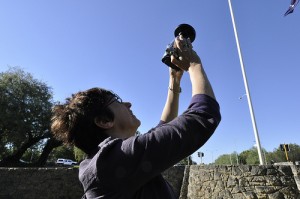Fulldome Cinema is a new media format, whose screen language remains largely undefined. As the Production Designer at the Melbourne Planetarium, with over five years experience in the creation of fulldome content, I am continually challenged by the medium.

Pointing the camera - up! Photographer: Eva Sprenkelder
With my experience I would like to be able to predict how scenes will work in a dome, and the impact they might have on the audience. Instead the results are invariably surprising. And there are just as many pleasant surprises as there are rude shocks. It is only through constant testing and re-testing of scenes that optimum results are achieved.
So it was with a mix of excitement and trepidation that I accepted the offer to be a Domelab tutor. Teaching anything is difficult when you are still trying to work it out for yourself, so I saw Domelab as an opportunity to pass on my knowledge, but also as a chance to experiment and learn.
Melbourne Planetarium productions are created using 3D animation software, which has advantages over live action. There is no limit on where to place the virtual camera, and we have more command over lighting and greater control to keep things in or out of frame. We can use a variety of lenses with different fields of view (anything from 150 -230 degrees can work in a dome), and there’s more potential for compositing elements from different sources.
Filming live action for Fulldome requires a fixed lens with a 180 degree field of view. This creates enormous challenges in camera placement, camera movement, mise-en-scene, lighting, sound recording, editing and post-production. In fact, every single element of fulldome production is more problematic than standard film production.

Extreme Close Up. Photographer: Eva Sprenkelder
On the first day of Domelab the tutors discussed production techniques, including many of the dos and mostly the don’ts of Fulldome. The most significant of these was to ensure the camera is oriented upwards. The Domelab participants were given cameras and told to go shoot something. Given all our advice and recommendations, we were surprised to find that half of the participants still pointed the camera forwards. Our traditional screen language is so innate that breaking its rules is incongruous. The participants had to learn this new medium by making all the mistakes of fulldome production for themselves.
Close ups are considered taboo in Fulldome; faces become distorted and unflattering. Yet the participants used them. Quite often they simply did not work, but there were one or two examples that worked extraordinarily well creating a powerful effect.
Direct edits tend to be avoided in Fulldome cinema as they are considered too abrupt on the audience. Instead fades to black and cross dissolves are the most common form of transition from shot to shot. But again the participants pushed the boundaries, using both direct cuts and rapid editing, the results while mixed, proved startling.
The final Domelab productions proved to be diverse in genre, approach, technique and execution. With ridiculously short production times, all of the works are uneven; the production standard for each film varies from shot to shot. When they were viewed there was an air of frustration as the participants realised how polished they could have made their productions, if given more time, and the opportunity to learn from their mistakes. But this was overwhelmed by the excitement, the creativity, the immersion, and audio and visual impact of their productions.
Domelab was a unique opportunity for both the tutors and participants; I believe we learnt volumes from each other. My final impression is the incredible excitement and enormous creativity that Domelab generated. It is one that gives me great faith for the future of Fulldome.
Warik Lawrance
Warik Lawrance has worked on television, film and fulldome productions for over a decade. His expertise in camera operation, computer-generated animation, design and compositing has contributed substantially to the success of the Melbourne Planetarium’s fulldome productions. He was one of three designers who produced the planetarium’s award-winning Black Holes: Journey into the Unknown, which pushed forward the cinematic boundaries of fulldome production and was awarded ‘Best Visual and Story Narrative’ at the 2007 Domefest.
Read More
http://museumvictoria.com.au/planetarium/
Watch More
Warik Lawrance’s presentation at DomeLab 2010
 This work is licensed under a Creative Commons Attribution-NonCommercial-ShareAlike 3.0 Australia.
This work is licensed under a Creative Commons Attribution-NonCommercial-ShareAlike 3.0 Australia.






